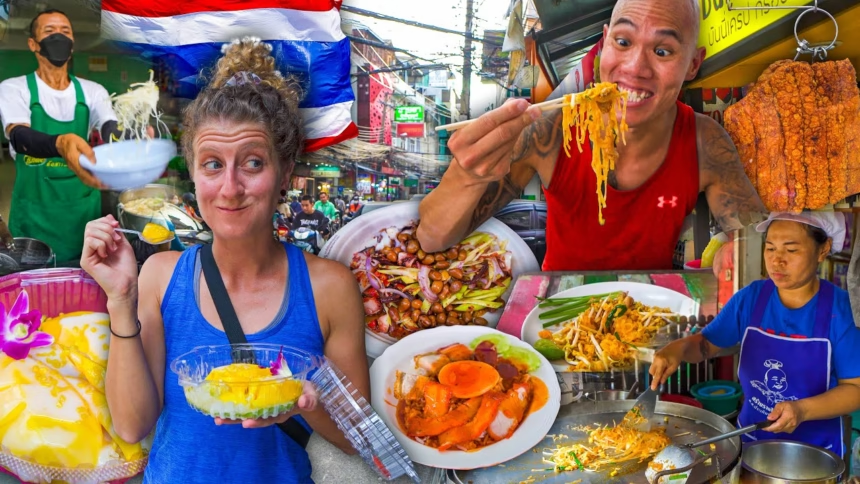BANGKOK – Thai night markets now feel much closer than a 12-hour flight. A scroll through TikTok is enough to smell the grill smoke, hear sizzling woks, and watch people sweat over fiery papaya salad. Thanks to short videos, fun dares, and smart hashtags, Thai Street Eats has jumped from Bangkok and Chiang Rai pavements to phone screens all over the world.
Creators post quick clips of spicy food dares, 24-hour eating challenges, and tight budget tests. The formula is simple. Point the camera at a busy stall, order something bold, press record, and enjoy real reactions. Viewers at home get both entertainment and a free guide for their next Thailand trip.
This guide shows how this trend works, what kind of food people try, and how it helps Thai vendors, travellers, and anyone curious about Thai Street Food.
Why Thai Street Food Is Perfect For TikTok Challenges
Thai Street Food was made for short, punchy videos. Bright colours jump off the screen, grills smoke in the background, and vendors work with fast, confident hands. In a 15-second clip, viewers see flame, hear crunch, and watch someone take a huge bite.
TikTok loves quick stories. Thai markets give thousands of them every night.
Colour, smoke, and sound: Thai markets that look great on camera
Thai street markets are crowded, noisy, and full of light. Neon signs shine over plastic stools. Smoke rises from skewers on hot charcoal. A giant wok throws noodles in the air.
Dishes like pad Thai, grilled pork skewers, mango sticky rice, and boat noodles all look great on camera. Pad Thai has bright orange noodles and green herbs. Mango sticky rice shows glossy yellow fruit and shiny white rice. Even a simple bowl of boat noodles looks rich and deep on video.
It is not only the colours. The sounds are just as strong. Sizzling oil, metal spatulas hitting the wok, knives chopping herbs, ladles pouring soup into bowls. These noises fit perfectly with short clips and ASMR-style videos, where people enjoy the sound as much as the look.
Many creators now film close-ups of a single stall, capturing the whole cooking process: oil going into the pan, garlic hitting the heat, noodles being tossed, and the final sprinkle of peanuts. Viewers feel almost like they are standing at the cart.
For anyone curious about what that looks like in 2025, the TikTok hashtag feed for Thai Street Food 2025 gives a live snapshot of current stalls, festivals, and street trends.
Bold flavours and spicy dares that fit the challenge culture
Thai food is famous for its strong flavours. Sweet, sour, salty, and spicy often hit at the same time. That power suits TikTok challenges very well.
Spicy dares are some of the most popular clips. People order extra hot som tam (papaya salad), fiery tom yum, or rich red curry with extra chilli. The camera stays close on their faces as they take a bite. Eyes water, noses run, and sometimes they end up laughing and gasping at the same time.
Viewers enjoy seeing honest reactions. Some creators rate each dish by heat level or give tips on surviving the spice, like eating sticky rice between bites or drinking milk instead of water. Others focus on unusual textures, such as chewy fish balls, crunchy pork skin, or slippery noodles.
For food fans who like big portions as well as big flavour, extreme challenges like the viral 8KG curry rice challenge in Bangkok show how far Thai Street Food can go in size and drama.
Cheap, fast, and fun: easy content for travellers and locals
Thai Street Food is usually affordable and quick to prepare. Many dishes are ready in a few minutes, which suits TikTok creators who want to film several plates in one outing.
This leads to popular formats such as:
- Budget challenges like “How much Thai Street Food can $100 buy?”
- Try-everything runs where creators sample 10 or more dishes in one market.
- 24-hour eating challenges that cover breakfast, lunch, snacks, and late-night food.
Because prices are low compared to many Western cities, both locals and tourists can join these challenges without spending too much. They pick up grilled pork with sticky rice in the morning, noodles at lunch, iced coffee in the afternoon, and skewers, desserts, and seafood at night.
These videos double as travel guides. Many viewers save them, then use them later when they visit the same market. A clip recorded in Bangkok or Chiang Rai can guide a future visitor straight to a stall months later.
Popular Thai Street Food TikTok Challenges Everyone Is Trying
By 2025, a few clear types of Thai Street Food TikTok challenges stand out. Each style gives viewers a different way to see Thai food culture in action.
24-hour Thai street food challenge in Bangkok and beyond
In a 24-hour Thai Street Food challenge, creators eat only street dishes for a whole day. Some are inspired by long-form food vloggers like Mark Wiens, then adapt the idea to short TikTok clips.
A typical day might look like this:
- Breakfast: Jok (rice porridge) with minced pork, or grilled pork skewers with sticky rice from a simple morning cart.
- Late morning snack: Iced Thai tea and a crispy pastry.
- Lunch: Pad Thai, boat noodles, or basil stir fry over rice.
- Afternoon snack: Fresh fruit, roti pancakes, or fried chicken.
- Evening: A night market walk with skewers, noodle soups, and grilled seafood.
- Dessert: Mango sticky rice, coconut ice cream, or Thai crepes.
Some challenges happen in Bangkok only, while others spread across Chiang Mai, Chiang Rai, or smaller provincial towns. The format gives a broad view of Thai Street Food, not just the famous dishes everyone already knows.
Budget Thai street food challenges that show real value
Budget Thai Street Food challenges focus on how far a fixed amount of money can go. A creator might set a limit like $20, $50, or $100, then see how many dishes they can try.
These videos often visit:
- Busy city markets with long rows of stalls.
- Regional markets that show local recipes.
- Pop-up night markets in smaller towns.
The result is a basket full of plates: spicy sausages, grilled duck, noodle soups, stir fries, coconut desserts, and sometimes insect snacks like fried crickets or silkworms.
Viewers like this format because it gives a clear idea of prices and portion sizes. It also highlights lesser-known dishes that might not appear in travel brochures. People planning a trip can get a sense of how much daily meals might cost and which markets are worth a visit.
Spicy and unusual food dares that get big reactions
Spicy and strange food dares are built for TikTok. They are short, intense, and full of big facial expressions.
Common dairy foods include:
- Extra hot som tam with lots of fresh chilli.
- Spicy frog curry or jungle curry with strong herbs.
- Raw or semi-raw Isaan meat salads.
- Mixed plates of fried insects.
Creators often rate the heat from 1 to 10, comment on the taste, and share quick survival tricks. Sometimes they win the challenge and finish everything. Other times, they tap out halfway through, which can be even more entertaining for viewers.
These clips do more than make people laugh. They show how wide and surprising Thai cuisine can be, far beyond the usual green curry and pad Thai.
ASMR Thai street food prep videos that people can’t stop watchinASMR-stylele Thai Street Food videos have become quite a hit. Instead of talking a lot, the creator lets the sounds tell the story.
A typical ASMR video might focus on:
- Meat sizzling on a hot grill.
- A wok clanging on high heat.
- Herbs are being chopped at high speed.
- Soup is being poured into a bowl, followed by a loud slurp.
Viewers often watch these clips to relax or to feel hungry on purpose. Many stalls in places like Bangkok’s Chinatown or popular night markets have become minor online stars because their setup looks and sounds so good on camera. Some creators combine the cooking sounds with a short taste test at the end, giving soft-spoken reviews.
How TikTok Thai Street Food Challenges Change Travel and Local Life
Viral Thai Street Food clips do not stay online. They also change how people travel, eat, and run small food businesses.
From viral video to real trip: viewers visit Thai markets
After watching enough Thai Street Food challenges, many viewers decide to book flights. They save their favourite videos and use them as live food maps. Once in Bangkok, Chiang Rai, or other cities, they walk through markets looking for the same signs or dishes they saw on TikTok.
Some markets get a new level of fame after they appear in many challenges. A small noodle stall can become a “must visit” spot for tourists who recognise the bowls and plastic chairs from their feed.
More customers and new fame for local street vendors
When a TikTok challenge at a stall goes viral, the effect on the vendor can be huge. Next week, there might be a long queue of people holding phones, ready to film their own plates.
Local vendors respond in different ways. Some stay shy and just keep cooking. Others start their own TikTok accounts, posting short clips of daily prep, opening hours, and friendly waves to the camera. Many now welcome customers who tag them, since each post brings new eyes to their stall.
More attention usually means more income, which can help small family businesses grow. At the same time, vendors may need to adjust to more foreign guests, explain dishes in simple English, and manage bigger crowds.
How Thai street food TikToks shape what people think Thai cuisine is
For many people outside Asia, TikTok is their first teacher on Thai cuisine. They see pad Thai, mango sticky rice, and extremely spicy salads over and over again. This can create a narrow picture of what Thai food is.
Thai Street Food on TikTok is bright, busy, and fun, but it is still only part of the full story. There are many regional soups, grilled dishes, mild curries, and homestyle plates that rarely appear in fast challenges.
Viewers who later travel to Thailand often discover this wider menu only when they step into local markets or small restaurants. TikTok works best as a starting point. It invites people in with strong visuals and clear hooks, then real-life eating can fill in the rest.
How To Join Thai Street Eats TikTok Challenges Safely And Respectfully
Anyone can try a Thai Street Food challenge, whether in Thailand or at a local Thai market abroad. A bit of planning and respect make the experience better for everyone.
Plan a simple challenge that fits your budget and comfort level
The best challenge is one that feels fun, not stressful. A person can choose from ideas like:
- A 224-hour Thai Street Food day.
- A fixed budget runs in a market.
- A spicy dare with one or two dishes.
- A “try 5 new dishes” mini tour.
There is no need to copy extreme eaters. Starting small is fine, such as trying three new plates in one night. It is important to listen to the body, especially with spice or unfamiliar ingredients, and to avoid ordering more food than can be eaten.
Reading up on basic Thai dishes first helps a lot. Knowing names like pad kra pao, khao man gai, or tom yum makes it easier to order at a busy stall.
Be polite on camera and support the people serving the food
Good TikTok content should not come at the cost of local comfort. When filming around vendors, it helps to:
- Ask before filming close-ups of faces or cooking.
- Stay out of the way of other customers.
- Speak kindly and show real gratitude.
Creators can also share the stall name or a clear shot of the sign, if the vendor agrees. Saying the price and location helps viewers and gives free promotion to the business. Paying fairly, avoiding haggling over tiny amounts, and leaving honest but respectful reviews keep things friendly.
The goal is to enjoy Thai Street Food and support local vendors, not just chase views or mock unfamiliar dishes.
Share useful tips in your caption so others can enjoy Thai street food too
A strong caption turns a fun clip into a real guide. Helpful details include:
- The name of the dish in English and, if possible, Thai.
- The rough price and portion size.
- The market or street name and city.
- A simple spice rating, from mild to fifieryClear hashtags like #ThaiStreetFood, #BangkokFood, or #StreetFoodChallenge make the clip easier to find. When creators share these small details, they help future travellers feel less nervous and more ready to try Thai Street Food respectfully.
Conclusion
Thai Street Food and TikTok challenges fit together perfectly. Short videos capture sizzling grills, bright plates, and bold flavours. Fun formats like 24-hour eating, budget runs, and spicy dares help viewers discover new dishes, while ASMR clips share the calm side of cooking sounds. In return, markets gain fresh attention, and small vendors often welcome new customers at their stalls.
This trend spreads Thai cuisine far beyond its borders and lets people taste with their eyes long before they visit. At the same time, it reminds viewers that there is always more to explore than a single viral dish. With a bit of curiosity, respect, and care for local culture, anyone can enjoy Thai Street Food, whether on a street corner in Thailand or through a screen at home.
Readers can use this guide as a starting point, then plan a small Thai Street Food challenge of their own, or save ideas for their next trip. The next great bite might already be waiting at a stall, just off camera.














